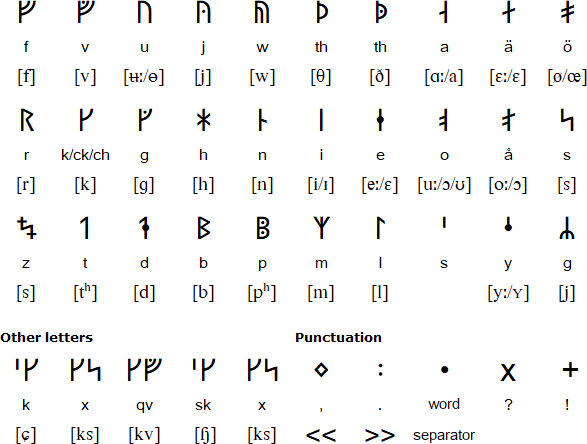Swedish Runes is a way to write Swedish with medieval runes devised by Sven Salvenson. Proto-Norse was written with Elder Futhark runes, and viking age runes were in Younger Futhark (an adaptation of Elder Futhark). Then early Old Norse was written in medieval runes (an adaption of Younger Futhark). Sven decided to carry on that tradition and adapt the medieval runic alphabet for modern Swedish.

Download an alphabet chart for Swedish Runes (Excel)
ᛂᚿ᛫ᛑᛆᚵ᛫ᛒᚯᚱᚤᛆᛑᛂ᛫ᛋᚮᛚᛂᚿ᛫ᚮᚴ᛫ᚡᛁᚿᛑᛂᚿ᛫ᛒᚱᚰᚴᛆ᛫ᚮᛉ᛫ᚡᛂᛉ᛫ᛆᚠ᛫ᛑᛂᛉ᛫ᛋᚮᛉ᛫ᚠᛆᚱ᛫ᛋᛐᛆᚱᚴᛆᛋᛐ᛬ᛑᛂ᛫ᚴᚢᚿᛑᛂ᛫ᛁᚿᛐᛂ᛫ᛂᚿᛆᛋ᛫ᛋᚰ᛫ᛑᛂ᛫ᛒᛂᛋᛐᛅᛉᛑᛂ᛫ᛋᛁᛦ᛫ᚠᚯᚱ᛫ᛆᛐ᛫ᚢᛚᛉᛆᚿᛆ᛫ᚡᛆᚱᛆᚿᛑᚱᛆ᛫ᛔᚰ᛫ᛂᚿ᛫ᛚᛁᛐᛂᚿ᛫ᛐᛅᚡᛚᛁᚿᚵ᛬"ᛋᛂᚱ᛫ᛑᚢ᛫ᛉᛆᚿᛂᚿ᛫ᛑᛅᚱ᛫ᚿᛂᚱᛂX"ᛋᛆᛑᛂ᛫ᚡᛁᚿᛑᛂᚿ ᛐᛁᛚ᛫ᛋᚮᛚᛂᚿ᛬"ᛚᚰᛐ᛫ᚮᛋ᛫ᛋᛂ᛫ᚡᛂᛉ᛫ᛋᚮᛉ᛫ᚴᛆᚿ᛫ᛋᛚᛁᛐᛆ᛫ᛆᚡ᛫ᛡᚮᚿᚮᛉ᛫ᚱᚮᚴᛂᚿ᛫ᛋᚿᛆᛒᚿᛋᛐ᛬"ᛑᛂᛐ᛫ᛦᛁᚴ᛫ᛋᚮᛚᛂᚿ᛫ᛉᛂᛑ᛫ᛔᚰ"ᛒᚯᚱᚤᛆ᛫ᛑᚢ"ᛜᛋᛆᛑᛂ᛫ᛋᚮᛚᛂᚿ᛫ᛐᛁᛚ᛫ᚡᛁᚿᛑᛂᚿ᛬ᚡᛁᚿᛑᛂᚿ᛫ᛑᚱᚮᚵ᛫ᛂᚠᛐᛂᚱ᛫ᛆᚿᛑᛆᚿ᛫ᚮᚴ᛫ᛌᚴᛁᚴᛆᛑᛂ᛫ᛁᚡᛅᚵ᛫ᛂᚿ᛫ᛋᚰ᛫ᚴᚱᛆᚠᛐᛁᚵ᛫ᛒᛚᚰᛋᛐ᛫ᛉᚮᛐ᛫ᛉᛆᚿᛂᚿ᛫ᛆᛐ᛫ᛡᛆᚿᛋ᛫ᚱᚮᚴ᛫ᚿᛂᛋᛐᛆᚿ᛫ᚠᛚᚯᚵ᛫ᛆᚡ᛫ᛡᚮᚿᚮᛉ᛫ᛑᛁᚱᛂᚴᛐ᛬ᚢᛔᛉᚢᚿᛐᚱᛆᛑ᛫ᛆᚡ᛫ᛑᛂᛐᛆ᛫ᚠᚯᚱᛐᛋᛆᛐᛂ᛫ᚡᛁᚿᛑᛂᚿ᛫ᛔᚢᛋᛐᛆ᛫ᛉᛂᛑ᛫ᛋᛁᚿ᛫ᛁᛋᚴᛆᛚᛆ᛫ᛆᚿᛑᛂᛑᚱᛅᚴᛐ᛬ᛉᛂᚿ᛫ᛉᛆᚿᛂᚿ᛫ᛡᚯᛚ᛫ᛐᛆᚵ᛫ᛁ᛫ᛋᛁᚿᛆ᛫ᚴᛚᛅᛑᛂᚱ᛫ᚮᚴ᛫ᚤᚢ᛫ᛡᚰᚱᛑᛆᚱᛂ᛫ᚡᛁᚿᛑᛂᚿ᛫ᛒᛚᚰᛋᛐᛂᛜᛑᛂᛋᛐᚮ᛫ᛉᛆᚱ᛫ᛋᚡᛂᛔᛐᛂ᛫ᛡᛆᚿ᛫ᛔᛚᛆᚵᛂᚿ᛫ᚴᚱᛁᚿᚵ᛫ᛋᛁᚿ᛫ᚴᚱᚮᛔ᛬ᛐᛁᛚ᛫ᛋᛚᚢᛐ᛫ᛐᚱᚯᛐᚿᛆᛑᛂ᛫ᚡᛁᚿᛑᛂᚿ᛫ᚮᚴ᛫ᛒᛚᛂᚡ᛫ᛐᚡᚢᚿᚵᛂᚿ᛫ᛂᛐ᛫ᚡᛁᛚᛆ᛫ᛋᛁᛦ᛬"ᚿᚢ᛫ᛅᚱ᛫ᛑᛂᛐ᛫ᛉᛁᚿ᛫ᛐᚢᚱ+"ᛋᛆᛑᛂ᛫ᛋᚮᛚᛂᚿ᛫ᚮᚴ᛫ᚤᛅᛋᛐᛂ᛫ᚢᛔ᛫ᛋᚰ᛫ᛉᛍᚴᛂᛐ᛫ᛡᛆᚿ᛫ᚴᚢᚿᛑᛂ᛬ᛑᛂ᛫ᚡᛅᚱᛉᛆ᛫ᛋᚮᛚᛋᛐᚱᚰᛚᛆᚱᚿᛆ᛫ᛌᚴᛂᚿ᛫ᚿᛂᚱ᛫ᚯᚡᛂᚱ᛫ᛚᛆᚿᛑᛋᚴᛆᛔᛂᛐ᛫ᛑᛅᚱ᛫ᛉᛆᚿᛂᚿ᛫ᛦᛁᚴ᛫ᚮᚴ᛫ᛋᚿᛆᚱᛐ᛫ᛒᚯᚱᚤᛆᛑᛂ᛫ᛡᛆᚿ᛫ᛋᚡᛂᛐᛆᛋ᛬ᛑᛂᛐ᛫ᛒᛚᛂᚡ᛫ᚡᛆᚱᛉᛆᚱᛂ᛬ᛐᛁᛚ᛫ᛋᛚᚢᛐ᛫ᚡᛆᚱ᛫ᛑᛂᛐ᛫ᛋᚮ᛫ᛡᛂᛐ᛫ᛆᛐ᛫ᛉᛆᚿᛂᚿ᛫ᛁᚿᛐᛂ᛫ᛋᛐᚮᛑ᛫ᚢᛐ᛫ᛚᛅᚿᚵᚱᛂᛜᚢᛐᛆᚿ᛫ᛐᚮᚵ᛫ᛆᚡ᛫ᛋᛁᛦ᛫ᚱᚮᚴᛂᚿ᛫ᚮᚴ᛫ᛡᛅᚿᚵᛑᛂ᛫ᛑᛂᚿ᛫ᛔᚰ᛫ᛆᚱᛉᛂᚿ᛬ᛑᛅᚱᛉᛂᛑ᛫ᛡᛆᛑᛂ᛫ᛋᚮᛚᛂᚿ᛫ᚡᛁᛋᛆᛐ᛫ᛆᛐ᛫ᛡᛆᚿ᛫ᚡᛆᚱ᛫ᛋᛐᛆᚱᚴᛆᛋᛐᛜᛉᛂᚿ᛫ᚴᛆᚿᛌᚴᛂ᛫ᛁᚿᛐᛂ᛫ᛔᚰ᛫ᛑᛂᛐ᛫ᛋᛅᛐ᛫ᛋᚮᛉ᛫ᚡᛁᚿᛑᛂᚿ᛫ᚱᛅᚴᚿᛆᛐ᛫ᛉᛂᛑ+
En dag började solen och vinden bråka om vem av dem som var starkast. De kunde inte enas, så de bestämde sig för att utmana varandra på en liten tävling. ”Ser du mannen där nere?” sade vinden till solen. ”Låt os se vem som kan slita av honom rocken snabbast.” Det gick solen med på. ”Börja du”, sade solen till vinden. Vinden drog efter andan och skickade iväg en så kraftig blåst mot mannen att hans rock nästan flög av honom direkt. Uppmuntrad av detta förtsatte vinden pusta med sin iskalla andedräkt. Men mannen höll tag i sina kläder och ju hårdare vinden blåste, desto mer svepte han plaggen kring sin kropp. Till slut tröttnade vinden och blev tvungen att vila sig. ”Nu är det min tur!” sade solen och jäste upp så mycket han kunde. De varma solstrålarna sken ner över landskapet där mannen gick och snart började han svettas. Det blev varmare och varmare. Till slut var det så hett att mannen inte stod ut längre, utan tog av sig rocken och hängde den på armen. Därmed hade solen visat att han var starkast, men kanske inte på det sätt som vinden räknat med!
One day the sun and the wind started arguing about which of them was the strongest. They couldn't agree, so they decided to challenge each other to a little competition. "Do you see the man down there?" said the wind to the sun. "Let's see who can rip off his coat the fastest." The sun agreed. "You begin," said the sun to the wind. The wind caught his breath and sent such a strong gust at the man that his coat almost flew off him instantly. Encouraged by this, the wind continued to blow its icy breath. But the man held on to his clothes and the harder the wind blew, the more he wrapped the clothes around his body. Finally the wind got tired and had to rest. "Now it's my turn!" said the sun, shining as much as he could. The warm rays of the sun shone down on the landscape where the man walked and soon he began to sweat. It got hotter and hotter. Finally, it was so hot that the man couldn't stand it anymore, but took off his coat and hung it on his arm. Thus the sun had shown that he was strongest, but perhaps not in the way that the wind expected!
This is a version of The North Wind and The Sun from Aesop's Fables. It is known as "Solen och vinden" (The Sun and the Wind) or "Vem var starkast?" (Who is strongest?) in Swedish.
Information about Swedish | Useful phrases | Silly phrases | Numbers | Colours | Family words | Time | Weather words | Idioms | Tongue twisters | Tower of Babel | Books about Swedish on: Amazon.com and Amazon.co.uk [affilate links]
Information about Runic alphabets
Note: A runic alphabet called Dalecarlian Runes, or Dalrunor, was used in the Swedish province of Dalarna/Dalecarlia until the 20th century, mainly to write the Elfdalian language, which is closely related to Swedish. They could also be used to write Swedish.
Constructed scripts for: Ainu | Arabic | Chinese languages | Dutch | English | Hawaiian | Hungarian | Japanese | Korean | Lingala | Malay & Indonesian | Persian | Tagalog / Filipino | Russian | Sanskrit | Spanish | Taino | Turkish | Vietnamese | Welsh | Other natural languages | Colour-based scripts | Tactile scripts | Phonetic/universal scripts | Constructed scripts for constructed languages | Adaptations of existing alphabets | Fictional alphabets | Magical alphabets | A-Z index | How to submit a constructed script
[top]
You can support this site by Buying Me A Coffee, and if you like what you see on this page, you can use the buttons below to share it with people you know.

If you like this site and find it useful, you can support it by making a donation via PayPal or Patreon, or by contributing in other ways. Omniglot is how I make my living.
Note: all links on this site to Amazon.com, Amazon.co.uk
and Amazon.fr
are affiliate links. This means I earn a commission if you click on any of them and buy something. So by clicking on these links you can help to support this site.
[top]